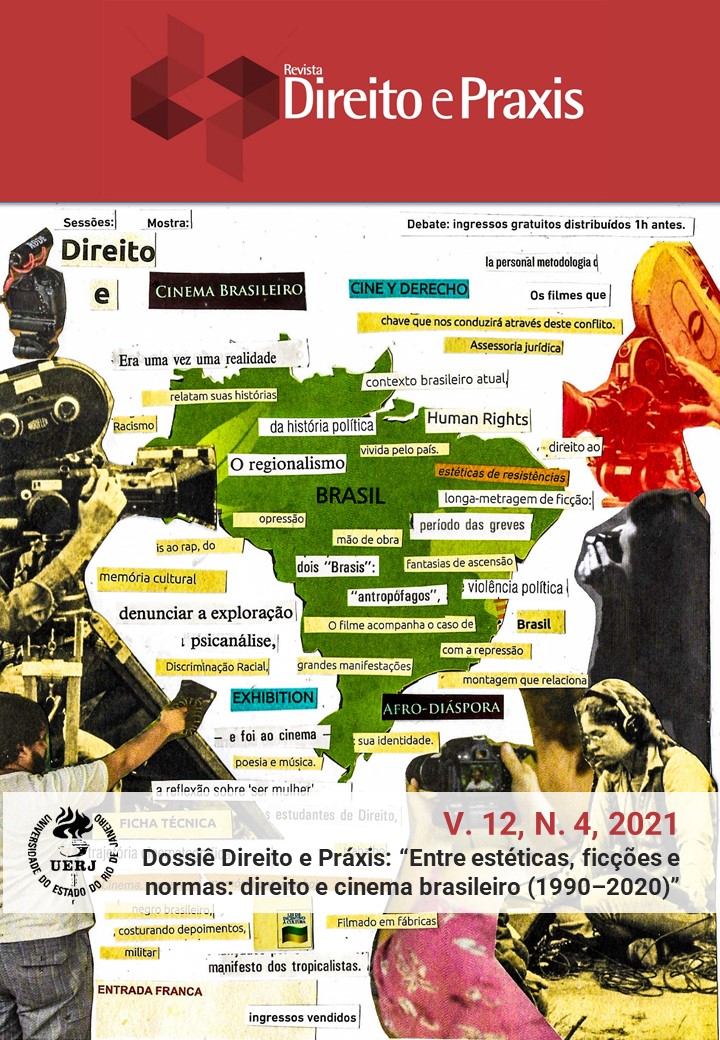Por que ‘Direito e Cinema’ e o que isso realmente significa? Uma Perspectiva / Why ‘Law-and-Film’ and What Does it Actually Mean? A Perspective
Keywords:
Julgamento cinematográfico, Jurisprudência popular, Direito e filme / Cinematic judgment, Popular jurisprudence, Law and film.Abstract
DOI: 10.1590/2179-8966/2021/
Resumo
O modesto objetivo deste artigo é apresentar aos leitores não iniciados o campo emergente e interdisciplinar do “direito e cinema”, ao mesmo tempo em que apresenta a estrutura de uma formulação dessa nova área de pesquisa. A primeira parte do artigo começa com uma breve visão geral da área de conhecimento sobre direito e cinema e prossegue para delinear minha própria sugestão de conceitualização do terreno de “direito e cinema”. Esta seção define três perspectivas distintas sobre o “direito e cinema” que, creio, capta grande parte do conceito de direito e cinema. Estas perspectivas se baseiam em três premissas fundamentais: que os modos de operação social de alguns filmes são paralelos aos da lei e do sistema legal; que alguns filmes emitem juízos de valor para o espectador; e que alguns filmes suscitam jurisprudência popular. As partes B, C e D deste artigo apresentam e exploram estas perspectivas com mais detalhes, ilustrando-as com exemplos específicos de filmes jurídicos. O artigo conclui com uma breve referência aos benefícios do uso do direito e cinema no ensino.
Palavras-chave: Julgamento cinematográfico; Jurisprudência popular; Direito e filme.
Abstract
This article’s modest goal is to introduce uninitiated readers to the emerging, interdisciplinary field of law-and-film, while presenting them with the framework of one formulation of this new area of research. The article’s first part opens with a brief overview of law-and-film scholarship and proceeds to outline my own suggested conceptualization of the law-and-film terrain. This framework defines three distinct perspectives on law- and-film that, I believe, capture much of the law-and-film enterprise. These perspectives rely on three fundamental premises: that some films’ modes of social operation parallel those of the law and legal system; that some films enact viewer-engaging judgment; and that some films elicit popular jurisprudence. Parts B, C and D of this article present and explore these perspectives in more detail, illustrating them with specific law-film examples. The paper concludes with a brief reference to the benefits of using law-and-film in teaching.
Keywords: Cinematic judgment; Popular jurisprudence; Law and film.
***
Tradução
João Zanine Barroso, Universidade do Estado do Rio de Janeiro, Rio de Janeiro, Rio de Janeiro, Brasil. E-mail: j_zanine@hotmail.com
Revisão
Bruna Mariz Bataglia Ferreira, Pontifícia Universidade Católica do Rio de Janeiro, Rio de Janeiro, Rio de Janeiro, Brasil. E-mail: brunabataglia@gmail.com
Flávia do Amaral Vieira, Universidade Federal do Pará, Belém, Pará, Brasil. E-mail: ei_flavia@hotmail.com
Downloads
Downloads
Published
How to Cite
Issue
Section
License
The authors the sole responsibility for their texts.
It is allowed the total or partial reproduction of the articles of the Journal Law and Praxis, if the author is mentioned.
This work is licensed under a Creative Commons Attribution-Noncommercial-Share Alike 4.0 Unported License.
This license allows you to copy and redistribute the material in any medium or format for any purpose, even commercial, provided the original authorship is cited.
This work is licensed under a Creative Commons Attribution 4.0 International License.



